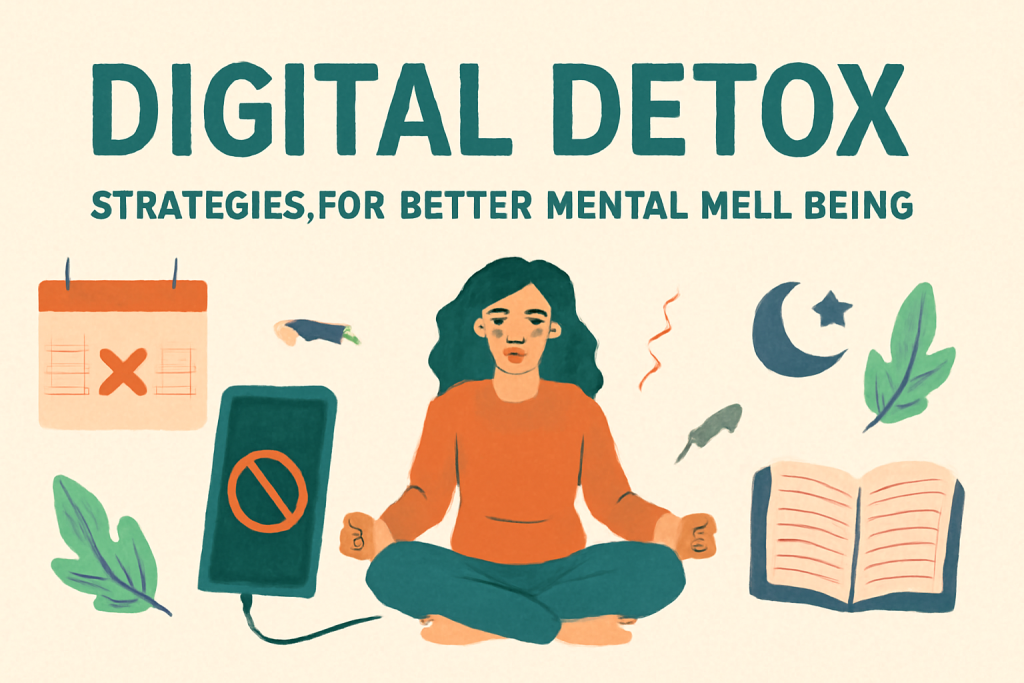
In today’s hyper-connected world, constant exposure to screens and digital devices can have a significant impact on mental health. While technology has its benefits, excessive use can lead to stress, anxiety, depression, and poor sleep quality. A digital detox offers a way to disconnect and regain balance in life. Here are some effective strategies for achieving better mental well-being through a digital detox:
1. Set Screen Time Limits
- What It Is: Use built-in features on your phone or download apps that track and limit your screen time. Set boundaries on how long you can spend on social media, news, or entertainment apps.
- Why It Helps: This helps you reclaim your time and focus on activities that promote mindfulness, like reading, exercising, or spending quality time with loved ones.
2. Designate Tech-Free Zones
- What It Is: Create areas in your home or office where electronic devices are not allowed, such as the bedroom or dining area.
- Why It Helps: This fosters a healthier environment for relaxation and sleep, and can enhance quality family time, leading to reduced anxiety and improved relationships.
3. Practice Mindfulness and Meditation
- What It Is: Incorporate mindfulness practices, such as deep breathing, meditation, or yoga, into your routine. Use apps like Headspace or Calm for guided sessions.
- Why It Helps: These practices calm the mind, reduce stress, and help you become more present in the moment, reducing the pull of constant notifications and distractions.
4. Schedule Digital-Free Days
- What It Is: Choose a day of the week, or even just a few hours, where you completely disconnect from all digital devices, including your phone, computer, and television.
- Why It Helps: It allows you to reset and focus on non-digital activities, such as nature walks, hobbies, or socializing without screens, leading to enhanced well-being.
5. Unsubscribe and Clean Up Your Digital Space
- What It Is: Unsubscribe from unnecessary email lists, unfollow accounts that do not add value to your life, and declutter your digital devices.
- Why It Helps: Reducing digital clutter helps lower stress and minimizes distractions, creating a more peaceful and organized digital environment.
6. Engage in Offline Hobbies
- What It Is: Reconnect with offline hobbies like drawing, gardening, cooking, reading, or hiking.
- Why It Helps: These activities reduce reliance on digital devices, help improve your focus, and boost your creativity and mental well-being.
7. Use Technology to Improve Your Detox
- What It Is: Use technology in a mindful way by downloading apps that promote well-being, such as sleep trackers, fitness apps, or journaling tools.
- Why It Helps: Technology can be used as a positive tool to support your mental health, making your digital detox more intentional and structured.
8. Be Mindful of Social Media Usage
- What It Is: Limit your social media usage or take breaks from it entirely. You can unfollow accounts that make you feel anxious or inadequate.
- Why It Helps: Social media can often contribute to feelings of inadequacy, jealousy, and anxiety. Reducing exposure helps protect your mental space and fosters a more positive outlook.
9. Prioritize Real-Life Social Interactions
- What It Is: Instead of texting or messaging online, make an effort to meet friends or family in person or via phone calls.
- Why It Helps: Face-to-face interactions or meaningful voice conversations build stronger emotional connections, contributing to better mental health.
10. Implement a “No Technology” Rule Before Bed
- What It Is: Set a time (e.g., an hour) before bed where all digital devices are turned off. Use this time to unwind and engage in relaxing activities like reading, journaling, or listening to music.
- Why It Helps: Reducing screen exposure before sleep promotes better sleep hygiene and improves mental well-being by preventing blue light from interfering with your natural sleep cycle.
Conclusion
A digital detox is an essential practice for improving mental health in a tech-heavy world. By following these strategies, you can create a healthier relationship with technology, leading to reduced stress, improved sleep, and overall better mental well-being.